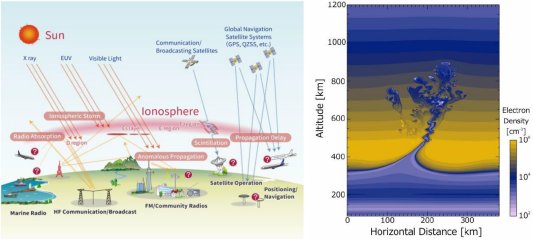要旨
The Earth’s atmosphere is extended up to about 1000 km, while the boundary between Earth’s atmosphere and the space is defined as 100 km by the Fédération Aéronautique Internationale (FAI) or 80 km defined by NASA and the US Air Force. This transition region from Earth to space is partially ionized by the solar radiation and called ionosphere. The ionosphere affects radio propagation in various ways. To guarantee the accuracy of positioning and navigation by Global Navigation Satellite Systems (GNSS) such as GPS, it is important to monitor and forecast daily ionospheric conditions. The research field in the solar-terrestrial system in terms of the influence on the social infrastructure is called “space weather”.
When severe ionospheric disturbances such as equatorial plasma bubbles occur, they may cause the fluctuation of the amplitude and phase of GNSS signals, which is called scintillation, and result in communication/navigation outage. We study the generation mechanism of the ionospheric disturbances by radar observations and numerical simulations in order to forecast the communication/navigation outage in advance.
 Figure: (left) Ionospheric effects on radio propagation (http://swc.nict.go.jp/).
Figure: (left) Ionospheric effects on radio propagation (http://swc.nict.go.jp/).
(right) Simulation result of equatorial plasma bubbles in the ionosphere.
印刷用PDFファイル(190 805 バイト) | ページ先頭へもどる
2019年5月29日作成


